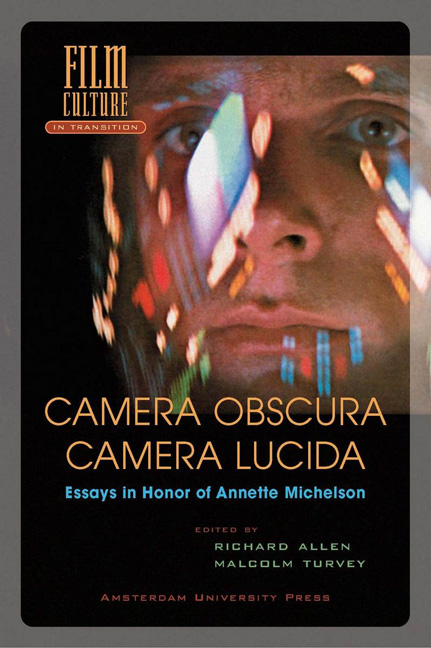Book contents
- Frontmatter
- Contents
- Acknowledgements
- Preface
- Introduction
- The Logic of an Illusion: Notes on the Genealogy of Intellectual Cinema
- Narcissistic Machines and Erotic Prostheses
- Loïe Fuller and the Art of Motion: Body, Light, Electricity and the Origins of Cinema
- Visitings of Awful Promise: The Cinema Seen from Etna
- Transfiguring the Urban Gray: László Moholy-Nagy’s Film Scenario ‘Dynamic of the Metropolis’
- Eisenstein’s Philosophy of Film
- Knight’s Moves
- Hitchcock and Narrative Suspense: Theory and Practice
- From the Air: A Genealogy of Antonioni’s Modernism
- Dr. Strangelove: or: the Apparatus of Nuclear Warfare
- Collection and Recollection: On Film Itineraries and Museum Walks
- Afterward: A Matter of Time: Analog Versus Digital, the Perennial Question of Shifting Technology and Its Implications for an Experimental Filmmaker’s Odyssey
- Select Bibliography
- List of Contributors
- Index
- Film Culture in Transition General Editor: Thomas Elsaesser
Collection and Recollection: On Film Itineraries and Museum Walks
Published online by Cambridge University Press: 25 January 2021
- Frontmatter
- Contents
- Acknowledgements
- Preface
- Introduction
- The Logic of an Illusion: Notes on the Genealogy of Intellectual Cinema
- Narcissistic Machines and Erotic Prostheses
- Loïe Fuller and the Art of Motion: Body, Light, Electricity and the Origins of Cinema
- Visitings of Awful Promise: The Cinema Seen from Etna
- Transfiguring the Urban Gray: László Moholy-Nagy’s Film Scenario ‘Dynamic of the Metropolis’
- Eisenstein’s Philosophy of Film
- Knight’s Moves
- Hitchcock and Narrative Suspense: Theory and Practice
- From the Air: A Genealogy of Antonioni’s Modernism
- Dr. Strangelove: or: the Apparatus of Nuclear Warfare
- Collection and Recollection: On Film Itineraries and Museum Walks
- Afterward: A Matter of Time: Analog Versus Digital, the Perennial Question of Shifting Technology and Its Implications for an Experimental Filmmaker’s Odyssey
- Select Bibliography
- List of Contributors
- Index
- Film Culture in Transition General Editor: Thomas Elsaesser
Summary
‘Recollection is a discarded garment.’
Søren KierkegaardAgarment, discarded.Atexture that holds a text. As part of an aesthetic collection that speaks of its wearer's taste, the discarded garment enacts recollection, recalling for us the person who inhabited its surface – the lively body that ‘animated’ it in motion. A familiar scenario for the artist Christian Boltanski, the material of the discarded garment embodies a projection: the textile surface acts as a screen. The filmic screen is also fiber, a material weave that absorbs and reflects. Such is the screen – the fabric – upon which the stories of history are inscribed.
It is from this narrative of the discarded garment that I would like to launch a reflection on the mobile activity of recollection. If this essay joins recollection and garment on a screen, it is to call attention to the ‘fashioning’ of archival space, considering, in particular, the place of cinema and the museum in this process. Ultimately, its aim is to foreground the interaction between film's imaginative route and the museum walk and, recognizing a reversible process at work, to link their emotive impact along the experiential path that includes acts of memory, the itinerary of the imagination, the place of collection, and the journey of recollection.
Cinema and memory have been linked since the inception of film history and theory. They are bonded, as we will see, in the very archaeology of the moving image and its exhibitionary spaces. In his 1916 pioneering study of cinema, Hugo Münsterberg introduced a model of theory that accounted for the intimate binding of film to affects and memory. Münsterberg underscored the psychic force of filmic representation and claimed that the medium itself is a ‘projection’ of the way our minds work. Cinema is a materialization of our psychic life. It makes visibly tangible all psychic phenomena, including the work of memory and of the imagination, the capacity for attention, the design of depth and movement, and the mapping of affects. In suggesting that with film, ‘we have really an objectivation of our memory function,’ Münsterberg claimed cinema's fundamental mnemonic function. Film is a medium that can not only reflect but also produce the layout of our mnemonic landscape. It is an agent of intersubjective and cultural memory.
- Type
- Chapter
- Information
- Camera Obscura, Camera LucidaEssays in Honor of Annette Michelson, pp. 231 - 260Publisher: Amsterdam University PressPrint publication year: 2003



